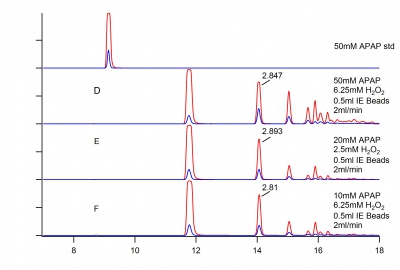Difference between revisions of "Ian Salveson: Research Log"
Jump to navigation
Jump to search
Ian Salveson (talk | contribs) |
Ian Salveson (talk | contribs) |
||
| Line 1: | Line 1: | ||
==June 16, 2016== | ==June 16, 2016== | ||
| − | Concentration of acetaminophen is increased in preparation for Flash Chromatography. Figure 1 below shows the effect of increasing | + | Concentration of acetaminophen is increased in preparation for Flash Chromatography. Figure 1 below shows the effect of increasing concentration on product formation. |
[[File:APAP-IE-50mM-1ml-min.jpg|400px|Figure 1]] | [[File:APAP-IE-50mM-1ml-min.jpg|400px|Figure 1]] | ||
| + | |||
| + | It appears that at higher concentrations, the reaction will begin to form polymeric material, despite relatively low concentrations of Hydrogen Peroxide. | ||
| + | |||
| + | Sample B will be separated using Flash Chromatography. | ||
| + | |||
| + | It is important to not that we have reached the max absorbance of our instrument. | ||
| + | |||
| + | Figure 2 below shows a set of samples under identical conditions as Figure 1 except with a flow rate of 2 ml/min. | ||
| + | [[File:APAP-IE-50mM-2ml-min.jpg|400px|Figure 2]] | ||
Revision as of 00:47, 20 June 2016
June 16, 2016
Concentration of acetaminophen is increased in preparation for Flash Chromatography. Figure 1 below shows the effect of increasing concentration on product formation.

It appears that at higher concentrations, the reaction will begin to form polymeric material, despite relatively low concentrations of Hydrogen Peroxide.
Sample B will be separated using Flash Chromatography.
It is important to not that we have reached the max absorbance of our instrument.
Figure 2 below shows a set of samples under identical conditions as Figure 1 except with a flow rate of 2 ml/min.
